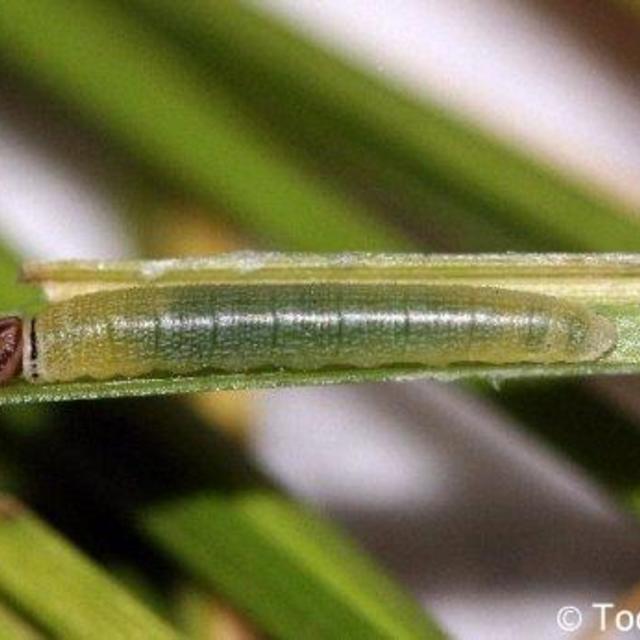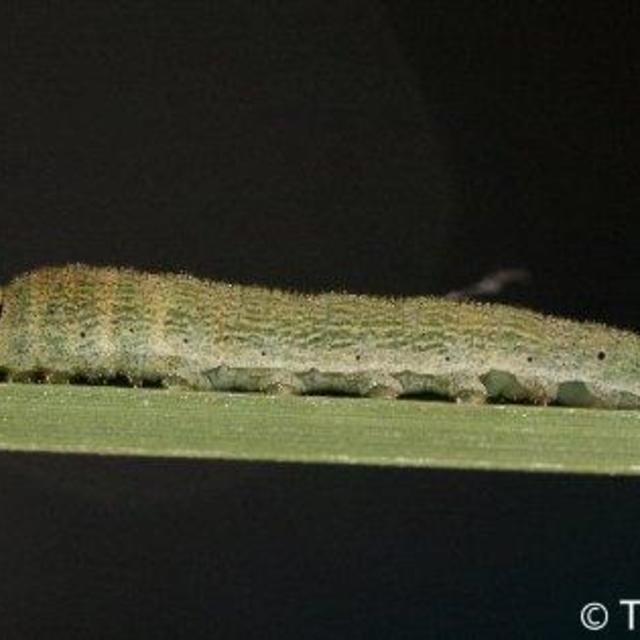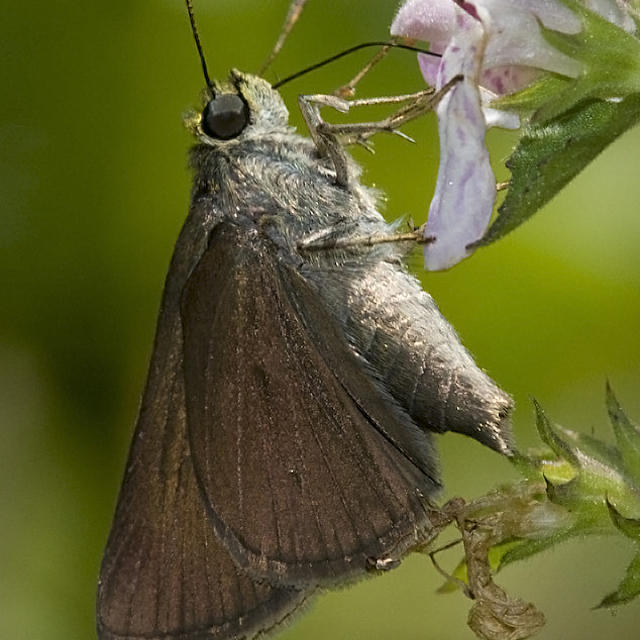Dun Skipper
Euphyes vestris (Boisduval, 1852)
Family: Hesperiidae
Subfamily: Hesperiinae
Identification: Upperside of head and thorax is yellow-orange. Wings are brown-black; male forewing has a black stigma, female forewing has very small cloudy white spots.
Wing Span: 1 1/8 - 1 3/8 inches (2.9 - 3.5 cm).
Life History: To find receptive females, males perch in low spots about 3 feet from the ground. Females lay eggs singly on leaves of the host plants. Caterpillars feed on leaves and make shelters of rolled or tied leaves. Third-stage caterpillars hibernate, emerge in the spring to complete their development, and pupate in silken tubes at the base of the plants.
Flight: One brood from June-early August in the north; two broods from May-September in the mid-South; several broods from March-October in the Deep South and Texas.
Caterpillar Hosts: Various sedges including chufa flatsedge (Cyperus esculentus) and sun sedge (Carex heliophila).
Adult Food: Nectar from white, pink, or purple flowers including common milkweed, purple vetch, selfheal, peppermint, dogbane, New Jersey tea, and viper's bugloss.
Habitat: Wet areas near deciduous woods such as meadows, seeps, swamp edges, and streams.
Range: Nova Scotia west across southern Canada to southern Alberta; south to Florida, the Gulf Coast, and eastern Texas. Separate populations in the high plains and Rocky Mountains, and on the Pacific Coast.
Conservation: Not usually required.
NCGR: G5 - Demonstrably secure globally, though it may be quite rare in parts of its range, especially at the periphery.
Management Needs: None reported.
Please donate!
We depend on donations to keep Butterflies and Moths of North America freely available. We want to express our gratitude to all who showed their support by making a contribution this year. You can donate to support this project at any time.
Advertise with us!
Do you have a product or service that you think would interest BAMONA users? If you would like to advertise on this website, contact us by email, or use the contact form and select the "Advertising" category.
Verified Sightings
Displaying 1 - 24 of 5103 verified sightings

Observation date: Jul 31, 2025
Submitted by: tnjbodker
Region: Maury County, Tennessee, United States
Verified by: CA Ivy
Verified date: Oct 24, 2025

Observation date: Aug 24, 2025
Submitted by: Kansasbirder
Region: Riley County, Kansas, United States
Verified by: jmgesell
Verified date: Oct 24, 2025

Observation date: Aug 17, 2025
Submitted by: AJ Trently
Region: Benton County, Tennessee, United States
Verified by: CA Ivy
Verified date: Oct 24, 2025
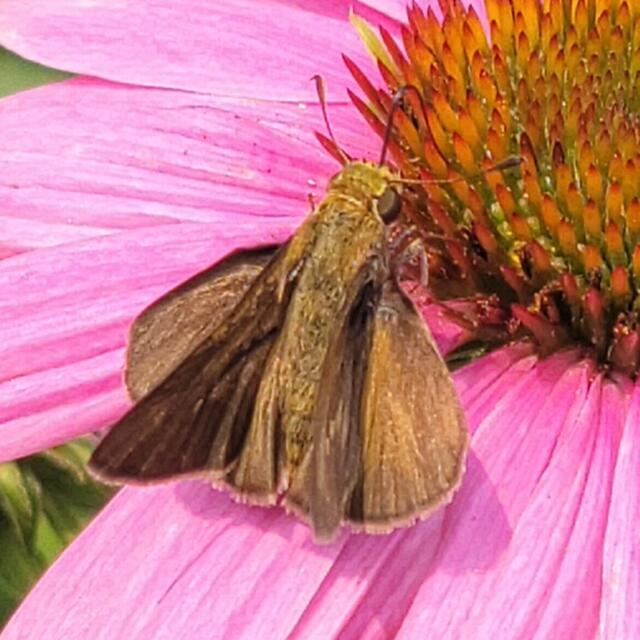
Observation date: Jul 13, 2025
Submitted by: aarongunnar
Region: Jefferson County, Wisconsin, United States
Verified by: jmgesell
Verified date: Sep 23, 2025

Observation date: Aug 16, 2025
Submitted by: Sometimes
Region: Ontario, Canada
Verified by: jmgesell
Verified date: Aug 17, 2025
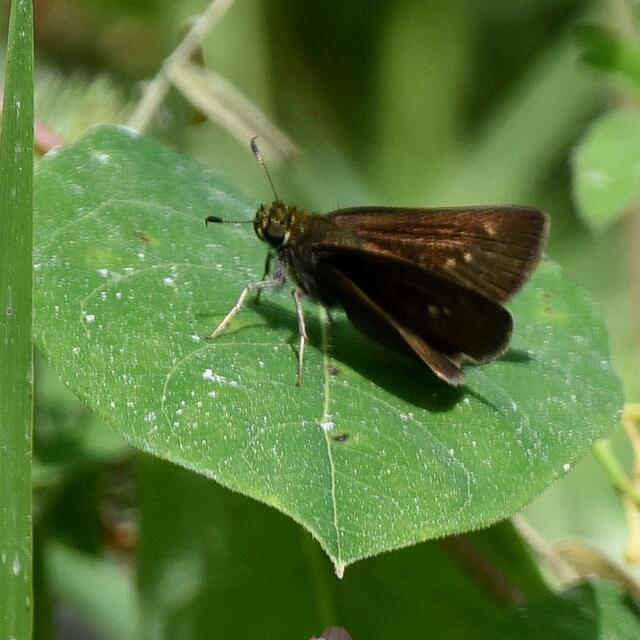
Observation date: Jul 09, 2025
Submitted by: John Terpstra
Region: Ontario, Canada
Verified by: jmgesell
Verified date: Aug 13, 2025

Observation date: Aug 07, 2025
Submitted by: Daniel Morton
Region: Lincoln County, Maine, United States
Verified by: John Calhoun
Verified date: Aug 09, 2025

Observation date: Aug 05, 2025
Submitted by: Daniel Morton
Region: Lincoln County, Maine, United States
Verified by: John Calhoun
Verified date: Aug 06, 2025

Observation date: Aug 04, 2025
Submitted by: Daniel Morton
Region: Lincoln County, Maine, United States
Verified by: John Calhoun
Verified date: Aug 05, 2025

Observation date: Aug 03, 2025
Submitted by: maryjanzen
Region: Huntingdon County, Pennsylvania, United States
Verified by: davidwright
Verified date: Aug 04, 2025

Observation date: Jul 09, 2025
Submitted by: okeefenmt
Region: Dane County, Wisconsin, United States
Verified by: jmgesell
Verified date: Aug 03, 2025

Observation date: Jul 20, 2025
Submitted by: Lady Vine
Region: Bristol County, Massachusetts, United States
Verified by: jwileyrains
Verified date: Jul 31, 2025

Observation date: Jun 17, 2025
Submitted by: Colleen K
Region: Robertson County, Tennessee, United States
Verified by: Dennis Forsythe
Verified date: Jul 27, 2025

Observation date: Jul 09, 2025
Submitted by: chirpus
Region: Albany County, New York, United States
Verified by: jmgesell
Verified date: Jul 24, 2025

Observation date: Jul 21, 2025
Submitted by: Razzlefish
Region: Ontario, Canada
Verified by: jmgesell
Verified date: Jul 22, 2025

Observation date: Jul 17, 2025
Submitted by: Sometimes
Region: Ontario, Canada
Verified by: jmgesell
Verified date: Jul 17, 2025

Observation date: Jul 15, 2025
Submitted by: Tom Dudones
Region: Franklin County, New York, United States
Verified by: jmgesell
Verified date: Jul 17, 2025

Observation date: Jul 14, 2025
Submitted by: Tom Dudones
Region: Franklin County, New York, United States
Verified by: jmgesell
Verified date: Jul 14, 2025

Observation date: Jul 14, 2025
Submitted by: Tom Dudones
Region: Franklin County, New York, United States
Verified by: jmgesell
Verified date: Jul 14, 2025

Observation date: Jul 14, 2025
Submitted by: Tom Dudones
Region: Franklin County, New York, United States
Verified by: jmgesell
Verified date: Jul 14, 2025

Observation date: Jul 18, 2020
Submitted by: Tom Dudones
Region: Essex County, New York, United States
Verified by: jmgesell
Verified date: Jul 13, 2025

Observation date: Jul 08, 2025
Submitted by: Cascade Colors
Region: Grand County, Colorado, United States
Verified by: mikefisher
Verified date: Jul 13, 2025

Observation date: Jul 11, 2025
Submitted by: Tom Dudones
Region: Franklin County, New York, United States
Verified by: jmgesell
Verified date: Jul 12, 2025

Observation date: Jul 11, 2025
Submitted by: Tom Dudones
Region: Franklin County, New York, United States
Verified by: jmgesell
Verified date: Jul 12, 2025
- 1 of 213
- next ›



